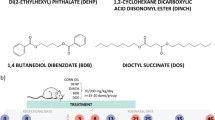Abstract
(14C)polychlorinated biphenyls [PCBs (KC-600)] were administered orally to female rats at the dose of 10 mg/kg in olive oil once a week for five weeks. Four weeks after the last administration of (14C)PCBs, they were mated with untreated males. The distribution of total14C was examined in maternal and offspring tissues. The average amount of PCBs accumulated in dams was 44.2% of the dose two weeks after the last administration. The average amount transferred from dam to fetus was 0.003% accumulated in the dam. In the fetus, the highest concentration was found in the fetal placenta followed by the liver, heart, skin, muscle, blood, lung, and brain. The PCBs level in fetal blood was the same as in maternal blood. The average concentration of PCBs in milk was 1.84 ppm. The amount transferred to sucklings increased gradually to about 5% of the maternal PCBs. In suckling rats, PCBs were distributed at the highest concentration in adipose tissues and at intermediate concentrations in the skin, adrenal gland, and liver. The liver to body weight ratio of offspring was significantly increased on the 11th and 25th days after birth. The nursing rats had lower PCBs concentrations compared with the pregnant and virgin rats. The organ concentrations of PCBs in dam and offspring were about ten times as high as those found after treatment with Kane-chlor®-400. These results may suggest that PCBs with higher chlorine content remained in tissues for a longer period of time.
Similar content being viewed by others
References
Allen JR, Barsotti DA (1976) The effects of transplacental and mammary movement of PCBs on infant rhesus monkey. Toxicol 6:331–340
Ando M (1978) Transfer of 2,4,5,2′,4′,5′-hexachlorobiphenyls and 2,2-bis-(p-chlorophenyl),1,1,1-trichloroethane(p,p′- DDT) from maternal to newborn and suckling rats. Arch Toxicol 41:179–186
Ando M, Saito H, Wakisaka, I (1985) Transfer of polychlorinated biphenyls (PCBs) to newborn infants through the placenta and mother's milk. Arch Environ Contam Toxicol 14:51–57
Biros FJ, Walker AC, Medbery A (1970) Polychlorinated biphenyls in human adipose tissue. Bull Environ Contam Toxicol 5:317–323
Brandt I (1975) Distribution of 2,2′,4,4′,5,5′-hexachlorobiphenyl in mice and Chinese hamsters. Arch Toxicol 34:111–119
Brandt I, Bergman A, Wachtmeister CA (1976) Distribution of polychlorinated biphenyls. Structural requirements for accumulation in the mouse bronchial mucosa. Experientia 32:497–498
Curley A, Bruse VW, Grim ME (1973) Polychlorinated bi-phenyls: Evidence of trnasplacental passage in the sherman rat. Fd Cosmet Toxicol 11:471–476
Department Health, Education, and Welfare Subcommittee on Health Effects of PCBs and PBBs (1978) General summary and conclusion. Environ Health Perspect 24:191–198
Goto M, Higuchi K (1969) The symptomatology of Yusho (chlorobiphenyls poisoning) in dermatology. Fukuoka Acta Med 60:409–431
Hashimoto K, Akasaka S, Takagi Y, Kataoka M, Otake T, Murata Y, Aburada S, Kitaura T, Uda H (1976) Distribution and excretion of (14C)polychlorinated biphenyls after their prolonged administration to male rats. Toxicol Appl Pharmacol 37:415–423
Hoizumi K, Moriya T (1974) Synthesis of carbon-14 labelled polychlorinated biphenyls. J Labelled Compd 10:499–508
Hutzinger O, Nash DM, Safe S, Defritas ASW, Norstrom RJ, Zitko V (1972) Polychlorinated biphenyls: Metabolic behavior of pure isomer in pigeons, rats and brook trout. Science 178:312–314
Ito N, Nagasaki H, Arai M, Makiura S, Sugihara S, Hirao K (1973) Histopathologic studies on liver tumorigenesis induced in mice by technical polychlorinated biphenyls and its promoting effect on liver tumors induced by benzene hexa-chloride. J Natl Cancer Inst 51:1637–1646
Kimbrough RD, Squire RA, Linder RE, Strandberg JD, Montali RJ, Burse VW (1975) Induction of liver tumors in Sherman strain female rats by polychlorinated biphenyl Aroclor® 1260. J Natl Cancer Inst 55:1453–1459
Masuda Y, Kagawa R, Kuratune M (1974) Comparison of poly-chlorinated biphenyls in Yusho patients and ordinary persons. Bull Environ Contam Toxicol 11:213–216
Matthews KB, Anderson MW (1975) Effect of chlorination on the distribution and excretion of polychlorinated biphenyls. Drug Metab Dispos 3:371–380
McCormack KM, Melrose P, Rickert DE, Dent JG, Gibson JE, Hook JB (1979) Concomitant dietary exposure to polychlorinated biphenyls and polybrominated biphenyls: Tissue distribution and aryl hydrocarbon hydroxylase activity in lactating rats. Toxicol Appl Pharmacol 47:95–104
Morales NM, Tuey DB, Colburn WA, Matthews HB (1979) Pharmacokinetics of multiple oral doses of selected polychlorinated biphenyls in mice. Toxicol Appl Pharmacol 48:397–407
Price HA, Welch RL (1972) Occurrence of polychlorinated bi-phenyls in humans. Environ Health Perspect 1:73–78
Risebrough RW, Reich P, Peakall DB, Herman SG, Kirven MN (1968) Polychlorinated biphenyls in global ecosystem. Nature 220:1098–1102
Schaeffer E, Greim H, Goessner W (1984) Pathology of chronic polychlorinated biphenyls (PCBs) feeding in rats. Toxicol Appl Pharmacol 75:278–288
Shigematsu N, Ishimura S, Ikeda T, Masuda Y (1977) Further studies on respiratory disorders in polychlorinated bi-phenyls (PCBs) poisoning: Relationship between respiratory disorder and PCB concentrations in blood and sputum. Fukuoka Acta Med 68:133–138
Takagi Y, Otake T, Kataoka M, Murata Y, Aburada S, Akasaka S, Hashimoto K, Uda H, Kitaura T (1976) Studies on the transfer and distribution of (14C)polychlorinated biphenyls from maternal to fetal and suckling rats. Toxicol Appl Pharmacol 38:549–558
Taki I, Hisanaga Y, Amagase Y (1969) Report on Yusho (chloro-biphenyls poisoning) pregnant women and their fetuses. Fukuoka Acta Med 60:471–474
Watanabe I, Yakushiji T, Kuwabara K, Yoshida S, Maeda K, Kashimoto T, Koyama K, Kunita N (1979) Surveillance of the daily PCB intake from diet of Japanese women from 1972 to 1976. Arch Environ Contam Toxicol 8:67–75
Yakushiji T, Watanabe I, Kuwabara K, Yoshida S, Koyama K, Kunita N (1979) Levels of polychlorinated biphenyls (PCBs) and organochlorine pesticides in human milk and blood collected in Osaka prefecture from 1972–1977. Int Arch Occup Environ Health 43:1–15
Author information
Authors and Affiliations
Rights and permissions
About this article
Cite this article
Takagi, Y., Aburada, S., Hashimoto, K. et al. Transfer and distribution of accumulated (14C)polychlorinated biphenyls from maternal to fetal and suckling rats. Arch. Environ. Contam. Toxicol. 15, 709–715 (1986). https://doi.org/10.1007/BF01054917
Received:
Revised:
Issue Date:
DOI: https://doi.org/10.1007/BF01054917




